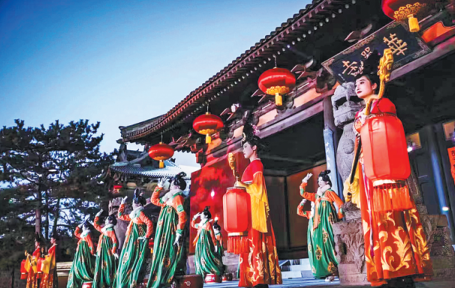New Year celebrations help to highlight city's history
Updated: 2023-02-03

Performers at Huayan Buddhist Temple, which is the main venue of celebrations in Datong. [Photo by Zhao Wengui for China Daily]
Datong in northern Shanxi, a historical city known for its rich cultural assets like the Buddhist arts treasure house of Yungang Grottoes; the old city wall and moat; and a number of ancient temples; streets and blocks, is attracting tourists with its grand Spring Festival celebrations.
The series of celebratory activities started on Jan 20 and will last to Feb 22, giving tourists an opportunity to experience the unique charm of how this important traditional Chinese festival is celebrated just as it was in the past.
The ancient streets and blocks of Datong, with Huayan Buddhist Temple at its center, have dedicated a great number of venues to the celebrations.
"We have planned a total of 106 events for the celebrations," said Meng Dechang, head of the Datong bureau of culture and tourism. "And most of the activities are being held in the ancient streets and blocks, including shows of folk arts, rituals related to Lunar New Year and food-tasting events."
The city is the most attractive to visitors when night falls and colorful lights and lanterns are lit.
The lanterns, featuring auspicious patterns and animals, have attracted many visitors to take pictures. As this year is the Year of the Rabbit in China, sculptures and lanterns featuring this cute animal can be seen everywhere in Datong.
The night is also host to various shows. Under the lanterns on the streets, craftsmen gather to demonstrate their skills in making items that have been around for many centuries, like sugar paintings and flour figurines. Performances of umbrella dancing, stilt walking, land-boating and float parades have also attracted a great number of visitors.
There are also performances of local operas, telling the long and brilliant history of Datong.
Datong is an ancient city of more than 2,000 years. It was at the forefront of cultural exchanges between the farming Han people and the nomads in the north and west.
Many of its well-preserved historical relics have stood witness to the unique ethnic and cultural exchanges. The Yungang Grottoes, one of the top three Buddhist cave art venues in China, for instance, showcased how Buddhist culture and arts evolved when the religion came all the way from India to China and then went to other countries in East Asia.
Zhang Qiang, mayor of Datong, said the city was in one of the first batches of historical and cultural cities in China recognized by State authorities.
He said the city is trying to retain its historical charms by protecting its ancient cultural assets and combining historical elements with modern life.
Zhao Zhicheng and Li Qiang contributed to this story.



